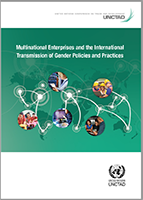The gender policies and practices of multinational enterprises (MNEs) affect gender equality in the workplace in host countries of foreign affiliates. Depending on an MNE’s home-country norms and values and those of its customer and stakeholder bases, outcomes in developing countries can be positive, although this is not automatic.
MNEs affect gender equality in host countries directly, through employment practices in foreign affiliates, and indirectly, through spillovers in local labour markets.
The direct effect is well documented – including in UNCTAD’s earlier work on foreign direct investment (FDI) and gender equality. It is especially pronounced in employment opportunities for higher-skilled women. For example, on average across developing countries, foreign affiliates employ about 5 percentage points more female administrative workers (just under 40 per cent) than local firms.
This report is the first to present empirical evidence on the indirect spillover effects to local firms and labour markets. It brings together a set of case studies – developed for this report and published separately – covering five countries across Africa, Asia and Latin America.
The adoption by MNEs of explicit non-discrimination policies ensuring equality in hiring practices, pay and promotion opportunities across their networks of affiliates is an important starting point for a positive impact. Active enforcement and support – for example to promote equal access to training, provide maternity leave without fear of repercussions, and avoid unfair dismissals – are necessary to translate global policies across societal and cultural differences.
Where MNE policies and practices result in broader positive gender equality outcomes in developing host countries, the effect is more pronounced for women’s employment and career advancement opportunities. The presence of foreign firms does not appear to contribute as much to closing the gender wage gap.
The main transmission mechanisms for MNE gender policies and practices to host economies are supply chain links with local firms, competition and demonstration effects, technology effects (i.e. the local adoption of technologies that favour female participation in the workfoce), and labour mobility (i.e. former employees of foreign affiliates joining local firms).
The relative importance and effectiveness of the various transmission mechanisms depends on country- and industry-specific circumstances. Examples from the country case studies illustrate this:
- In the Bangladeshi textile and garments industry, downstream business partners of MNEs were found to have 50 per cent more female administrative workers than local firms. In addition, domestic firms that shared the same domestic supplier as MNEs hired more female administrative workers. Thus, the presence of MNEs affects gender practices of domestic firms through upstream and downstream supply-chain linkages and demonstration effects.
- Evidence from Brazil shows that, although labour mobility appears to be a weaker transmission mechanism for gender policies and practices, it contributed to reducing the wage gap in the transportation and communications industry by about one-fifth.
- In contrast, in the Costa Rican information and communications technology sector, the effects of labour mobility and of competition and demonstration proved relatively strong. The effects were boosted by the high share (almost two-thirds) of employees of local firms having worked for foreign affiliates, leading to very similar gender practices across the sector.
- In geographical regions with foreign affiliates in more technology-intensive sectors in Viet Nam, increased FDI was found to be associated with higher female employment. However, much of the employment gain was at the bottom 10 per cent of the wage distribution.
- The direct effect of MNEs on gender policies and practices is confirmed by the experience of South Africa, where foreign affiliates hire more women at higher skill levels and offer a wage more than double the average in domestic firms, although the gender wage gap remains.
The various transmission mechanisms are interdependent and mutually reinforcing, and their impact is difficult to measure separately. However, distinguishing the individual mechanisms is helpful for the identification of targeted policy approaches. For example, supplier capacity-building initiatives, exchange programmes, training, and awareness or role model campaigns can be effective in disseminating the gender equality practices of MNEs. Host-country policies and programmes aimed at strengthening local absorptive capacity and developing inclusive linkages are most important.
Home-country policies can also promote positive gender equality outcomes. Where governments in developed economies provide support to MNEs for investment overseas, especially in low-income countries, through outward investment promotion organizations or in the form of investment guarantee schemes, such mechanisms can be made conditional on reporting on gender practices throughout affiliate networks.
Finally, the transmission of positive gender policies and practices can be advanced through international standards and through the global policy environment for investment. International reporting standards are key to driving a positive impact.
Currently, among the 100 largest MNEs, only 23 report on gender practices in their global networks. As for the global policy environment, including gender equality objectives in trade and investment agreements could help in attaining those objectives, for example by discouraging the lowering of labour market standards for the purpose of promoting investment.



